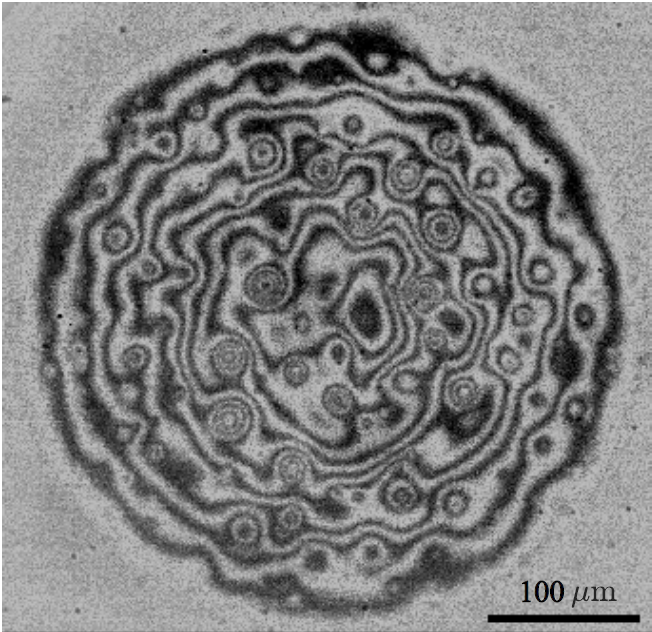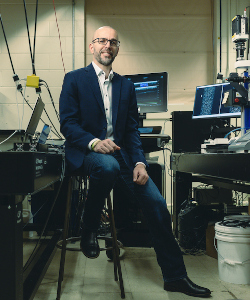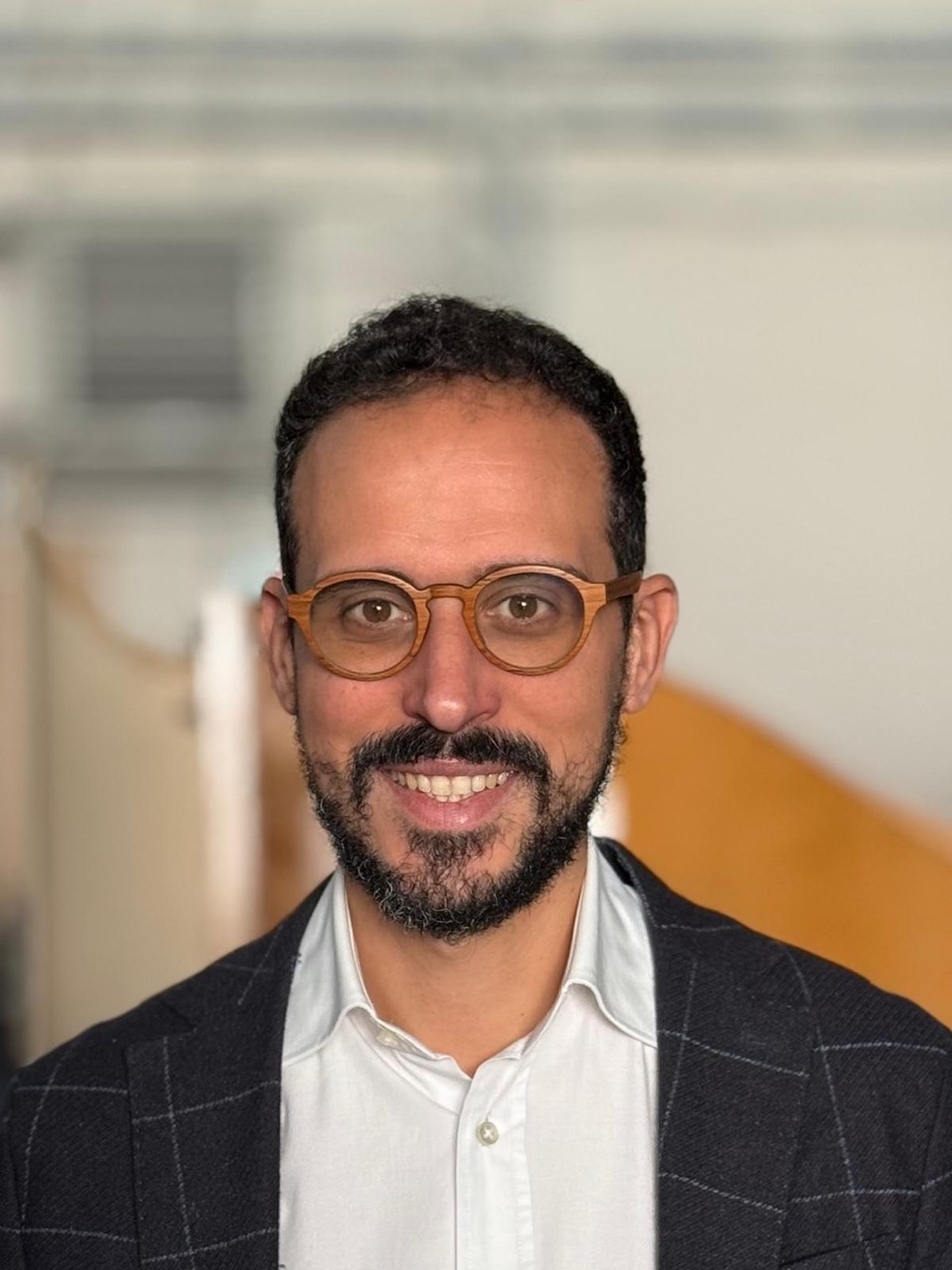

This page will be updated regularly as speakers are confirmed.

"Temperature imaging in gas and liquid flows using luminescent particles"
The visualization and quantification of thermal mixing in turbulent fluid flows is key to the development of accurate turbulence modelling. These models are needed to predict the behaviour of flows in industrially relevant applications as well as geophysical flows (ocean, atmosphere, earth’s mantle, etc.). This talk will describe thermometry techniques based on luminescent tracer particles which can be combined with particle-based velocimetry to image both temperature and velocity in laboratory flows. The emphasis will be mostly on inorganic luminescent crystals, typically referred to as thermographic phosphors. These particles exhibit a wide range of luminescence properties and can be chosen to match the application needs, e.g., for use in cryogenic flows, at physiological temperatures, or up to 1000 K. There are also various implementations of this measurement concept. We can exploit the temperature dependence of the luminescence emission spectrum or the decay time of the particles to measure the temperature. The velocity can be measured simultaneously using temporally separated images of the particles using light scattering as in traditional PIV, using luminescence light or even single images of phosphorescence streaks caused by the motion of the particles during their luminescence decay. Recent developments include high-resolution measurements in submillimeter boundary layers, a proof-of-concept study of 3D temperature and velocity measurements in gas flows, and 2D thermometry in water with sub-°C precision. Finally, we will show how, through chemical synthesis, we can tune the particle luminescence properties to exactly match the temperature range of our application, for example, around 100°C to study boiling.
 (Click picture to enlarge)
(Click picture to enlarge)
Figures: Left: Temperature and velocity field measured in the airflow in the wake of a heated cylinder [1]
Middle: Temperature fields in a water filled cuvette shortly after cold water injection [2].
Right: 3D scatter plots of temperature and velocity data measured in a turbulent heated jet [3].
1. C. Abram, B. Fond, A.L. Heyes, F. Beyrau, High-speed planar thermometry and velocimetry using thermographic phosphor particles. Appl. Phys. B 111, 155–160 (2013).
2. C. Abram, I W. Panjikkaran, S N. Ogugua, and B. Fond, "ScVO4:Bi3+ thermographic phosphor particles for fluid temperature imaging with sub-°C precision," Opt. Lett. 45, 3893-3896 (2020)
3. M. Stelter, F.W.A. Martins, F. Beyrau, B. Fond, Thermographic 3D particle tracking velocimetry for turbulent gas flows, Meas. Sci. Technol. 34 074008 (2023)
Bio:
Dr. Benoît Fond is in charge of luminescence-based optical diagnostics at ONERA, the French Aerospace Lab, and Paris Saclay University. After a French engineering degree and an MSc from the University of Florida, he obtained his PhD in Mechanical Engineering from Imperial College London in 2014. In 2016, he was appointed Junior Professor of Experimental Thermofluids at the University of Magdeburg in Germany and joined ONERA in 2021 to lead the development of pressure- and temperature-sensitive paints (PSP/TSP). Dr. Fond’s works focus on experimental fluid mechanics, leveraging luminescent materials for thermometry or pressure sensing, whether on surfaces or in fluid flows, with various applications for batteries, combustion, chemical processes, hydrogeology, aerodynamics, and more. Dr. Fond is also a lecturer at the international PSP/TSP course organized by DLR Göttingen, Germany, and was invited to the Laser Diagnostics for Energy and Combustion Science Gordon Research Conference in 2023.

"High-speed imaging in multiphase flows: Fine sheets of air and liquids"
The splashing of a drop impacting on a liquid surface is emblematic of the complexity of multiphase flows. Despite the drop’s small size ~5 mm, the ejecta dynamics are controlled by interactions on a wide range of scales. The first contact entraps a thin sheet of air under the bottom of the drop, which is about a micron thick, while the ejecta emerging from the neck between the drop and pool, is of the order of 5 microns, becoming thinner with increasing impact Reynolds numbers. Understanding the breakup of these fine structures is important in many industrial and natural phenomena. We use ultra-high-speed video, at up to 7 million fps, in combination with interferometry, to capture the breakup of these structures. This includes the generation of the double-crown driven by internal vortex rings [1] and the formation of spiky contacts for the impact of an emulsion droplet [2]. Finally, new results will be shown for high impact velocities at ~20 m/s, by drops free-falling in a 25-m-long vacuum tube, revealing novel breakup dynamics of the dancing ejecta [3].

 (Click picture to enlarge)
(Click picture to enlarge)
Figures: Left: The double crown formed when a viscous drop impacts a low-viscosity liquid film [1].
Right: Bottom-view of an air-disc entrapped under an emulsion drop impacting on a glass surface, showing localized spikes from the heavier emulsion droplets [2].
1. Aljedaani, A. B., Afzaal, M. F., Langley, K. R., Yang, Z. Q. & Thoroddsen, S. T. Double crown during drop impact on an immiscible shallow pool, in press at J. Fluid Mech. (2025).
2. Raja, K., Daniel, D., Aguirre-Pablo, A. A. & Thoroddsen, S. T., Local spiky contacts during impact of an emulsion drop on a solid surface. J. Fluid Mech. 1001, A60 (2024).
3. Tian, Y. S., Aljedaani, A. B., Alghamdi, T. & Thoroddsen, S. T., Dancing ejecta, J. Fluid Mech. 981, A4 (2024).
Bio:
Dr. Sigurdur Thoroddsen is a Professor in the Physical Sciences and Engineering Division at King Abdullah University of Science and Technology (KAUST), which he joined as a founding faculty in 2009. Thoroddsen received a BS in ME from his home-country at University of Iceland, followed by MS in Civil Engineering from Colorado State University and PhD in Applied Mechanics from UC San Diego in 1991.
He started as an Assistant Professor in Theoretical and Applied Mechanics at the University of Illinois, Urbana-Champaign. Then became an Associate Professor in ME at the National University of Singapore, before joining KAUST to set up the High-Speed Fluids Imaging Laboratory, with a focus on experimental fluid mechanics with high-speed imaging of free-surface flows, such as drops and bubbles, focusing on splashing, coalescence and singular jetting.
Thoroddsen has authored 200 publications in international scientific journals, describing his work on turbulence, coating flows and granular jets, in addition to his studies of the dynamics of drops and bubbles. His images and videos of flow phenomena have received seven separate Gallery of Fluid Motion Awards. He was elected a Fellow of the American Physical Society in 2012.

Advancing Flow Velocity Measurements with 4D Flow MRI: From Lab to Clinic
Flow velocity measurements are crucial for understanding complex cardiovascular flow dynamics, particularly in disease states. This lecture focuses on the latest advancements in flow velocity quantification using 4D Flow MRI, emphasizing accuracy, reliability, and clinical utility.
I will discuss recent developments addressing key challenges associated with 4D Flow MRI, including methods to overcome image noise, resolution limitations, and velocity reconstruction errors. Advanced techniques such as phase unwrapping, physics-informed data augmentation, denoising algorithms, and sophisticated bias error modeling will be presented.
Furthermore, I will highlight refined approaches for deriving precise flow metrics, including wall shear stress, relative pressure, and energy losses, from velocity data. Clinical case studies will demonstrate how these improved measurement techniques directly link cardiovascular flow characteristics to the diagnosis and monitoring of diseases like congenital heart defects, aneurysms, and heart failure. Ultimately, these innovations in 4D Flow MRI hold significant promise for enhancing diagnostic accuracy, informing treatment decisions, and improving patient outcomes.
Bio:
Prof.Dr. Pavlos Vlachos is a professor in Mechanical Engineering and Biomedical Engineering (by courtesy) at Purdue University, where he serves as the St. Vincent Health Professor of Healthcare Engineering. He directs the Regenstrief Center for Healthcare Engineering and the Eli Lilly and Purdue University Research Alliance Center.
Prof.Dr. Vlachos received his Diploma in Mechanical Engineering from the National Technical University of Athens (1995), and his M.S. (1998) and Ph.D. (2000) in Engineering Science and Mechanics from Virginia Tech. He began his academic career at Virginia Tech, advancing from assistant professor (2003) to full professor (2011), before joining Purdue in 2013.
His research spans biofluids, biomechanics, cardiovascular diseases, drug delivery, congenital heart defects, cerebral aneurysms, diagnostic imaging with ultrasound and MRI, tissue biotransport, and nanoparticle-based therapies. He has secured funding for over 90 projects, authored nearly 200 journal articles and over 330 conference papers, holds 12 patents (5 licensed), and supervised numerous postdocs and graduate students.
Prof.Dr. Vlachos is a Fellow of several prestigious organizations, including ASME, AIMBE, AHA, and APS. His awards include the NSF CAREER Award, the MIT T.F. Ogilvie Lectureship Award, and numerous awards recognizing excellence in research and teaching.

"Flow field and heat transfer performances of a synthetic jet-controlled sweeping jet"
Fluidic oscillators are devices capable of converting a steady jet into an oscillating jet, the motion of which is driven solely by the internal fluid dynamics and instabilities within the device. The interest in such devices has grown over the years, especially in the flow control and heat transfer fields. These jets are employed because their periodic coherent oscillation can promote a more significant control on the flow field as well as higher or more uniform heat transfer at low and high nozzle-to-plate distances, respectively.
However, for all the designs proposed for fluidic oscillators, it is not possible to modify the frequency of oscillation or its amplitude, without varying the main jet Reynolds number or the geometry of the device itself. In this research, a novel device, that is able to overcome this limitation, is presented. Such a device consists of two synthetic jets, driven in phase opposition, controlling a main steady jet issued through a square exit nozzle, thus resulting into a sweeping jet. The flow field and thermal performances of the jet in its baseline (i.e. without control) and controlled configurations, characterized by different values of the momentum coefficient Cu and the Strouhal number St, are experimentally investigated by means of Particle Image Velocimetry and Infrared thermography coupled with the heated thin foil technique.
Results suggest that the sweeping oscillation of the main jet increases with the synthetic jets momentum coefficient, while the increase of their Strouhal number mainly influences the curvature of the jet itself.
In addition to that, the momentum coefficient and the Strouhal number also govern the spatial distribution of the phase-organized and random turbulent fluctuations as well as the generation and evolution of coherent vortical structures, i.e. head vortices. These fluid dynamic features drastically influence the heat transfer performances. As a matter of fact, at low impingement distances due to the inclination achieved by the controlled jet, the heat transfer performances of the controlled configurations with largest Cu are superior to those of the steady jet in the stagnation region. Conversely, as the impingement distance increases, the controlled configurations provide regions of maximum convective heat transfer with greater uniformity. Such a uniformity is mainly related to the formation and evolution of the head vortices.
Bio:
Carlo Salvatore Greco is an Associate Professor of Fluid Dynamics at the Department of Industrial Engineering, Università di Napoli "Federico II". He earned his Master's degree in Aerospace Engineering in 2011 and was awarded a Ph.D. in 2015. In 2016, he joined the University of Naples as a staff researcher.
His research focuses on Flow Control, Heat Transfer, and Aerodynamics, utilizing both experimental techniques and numerical simulations. His work is documented in over 30 publications, many of which have appeared in leading international journals such as Aerospace Science and Technology, AIAA Journal, Journal of Fluid Mechanics, and International Journal of Heat and Mass Transfer.
He has collaborated with several international research teams within funded programs and is currently leading two scientific projects funded by the Italian Ministry of Research. Since 2013, he has been a member of the International Centre for Heat and Mass Transfer Scientific Committee and the Scientific Advisory Board of the Quantitative InfraRed Thermography Journal.

"Quantitative Flow Visualization in Multiscale and Multidisciplinary Thermal-Fluid Sciences"
Pressure/temperature-sensitive paint (PSP/TSP) techniques have been developed for decades and have been used extensively not only in aerodynamics but also extended their applications to other engineering aspects such as thermodynamics and heat transfer. These novel experiment methods provide non-intrusive measurements with optical access to flow fields and are capable of both qualitative observations such as flow visualization and quantitative measurements for pressure and temperature data with spatial resolutions as fine as a few micrometers. Promising results have been obtained from various research topics ranging from aerospace engineering, mechanical engineering, to microfluidics
Bio:
Dr. Chih-Yung Huang is currently a professor and Chair in the Department of Power Mechanical Engineering at National Tsing Hua University in Taiwan. He received his Master degree from the Institute of Aeronautics and Astronautics at National Cheng Kung University in Taiwan in 1997 and Ph. D. degree from the School of Aeronautics and Astronautics at Purdue University in USA in 2006. His research interests include microfluidics, pressure and temperature sensitive paint techniques, molecule-scale sensor applications in macro-meso-micro scale mechanics, optical diagnostic techniques in aerospace engineering, MEMS, and green energy. Dr. Huang’s research work has published more than 60 papers in scientific journals including AIAA Journal, Aerospace Science and Technology, International Journal of Heat and Mass Transfer, and Journal of Micromechanics and Microengineering, and presented at over 100 international conferences. With his excellent work in the area of experimental research, Dr. Huang received the title of AIAA Associate Fellow in 2022, RAeS Fellow in 2023, and ASME Fellow in 2024.

"The Ring of Fire Approach: Large-Scale Quantitative Flow Visualizations of Transiting Objects"
Many practical problems in fluid mechanics involve large objects, whose characteristic length is of the order of 1 m, having complex geometries and in relative motion with respect to the surrounding air. The development of large-scale Particle Image Velocimetry (PIV) and Lagrangian Particle Tracking (LPT) with sub-millimetre Helium-Filled Soap Bubbles (HFSB) flow tracers has paved the way for the quantitative visualization of such flows. However, measurements in wind tunnels suffer from the limited extent of the measurement domain and fail to reproduce the actual aerodynamic conditions encountered in the real operating environment.
This talk will discuss the development of the Ring of Fire approach, which leverages an on-site large-scale PIV/LPT measurement system for the aerodynamic characterization of transiting models. The approach relies on tracking the HFSB tracers before and after the passage of a transiting object, and employs the conservation of momentum in a control volume moving with the object to retrieve the aerodynamic drag. The drag resolution of the approach is assessed via dedicated measurements and comparisons with state-of-the-art approaches. Applications will be shown in the realm of speed sports, including cycling, running and speed-skating, on actual athletes during the sport action, whereby the aerodynamic drag constitutes up to 90% of the resistive force the athlete shall overcome. In this context, the Ring of Fire approach has been successfully employed to provide athletes with feedback on how to improve their posture or modify their garment to minimize the air resistance. Furthermore, the talk will showcase applications for automotive aerodynamics, whereby the wake flow topology of a real car has been evaluated and compared to CFD simulations. Finally, the approach is employed for the aerodynamic characterisation of a car’s underbody, which is optically inaccessible in conventional wind tunnel measurements employing a rolling floor.
Bio:
Dr. Andrea Sciacchitano is Associate Professor at the Delft University of Technology, the Netherlands, where he received his doctoral degree in 2014. His research focuses on the development and application of measurement techniques for the quantitative visualization of fluid flows. In the recent years, Andrea and his team have introduced the Ring-of-Fire concept, which leverages an on-site large-scale PIV setup to enable unprecedented wake analyses and aerodynamic load characterisations of transiting objects. Andrea currently acts as scientific director of the TU Delft Sports Engineering Institute and chairman of the Knowledge Network Committee of the European Research Community on Flow, Turbulence and Combustion (ERCOFTAC). In his career, he has co-author over 50 publications in international scientific journals and two book chapters.

Data Assimilation for Multi-physical Fields Reconstruction in Complex Turbulence
Data assimilation (DA) is a computational processing method that integrates experimental measurements (observations) with physical models (predictive models). It is widely used in fields such as atmospheric and oceanic dynamics, as well as geophysical hydrology. Using assimilation algorithms, DA optimizes estimates of experimental or model errors, ensuring that global state parameters closely approximate measured data within their uncertainty bounds during physical equation computations. Unlike big-data-driven machine learning, data assimilation relies on small-sample data and accounts for inherent data uncertainties. By adjusting the model's trajectory, it enhances predictive accuracy. In turbulent flow applications, DA typically employs flow governing equations and turbulence models as physical frameworks. These reconstruct high-dimensional multi-physical fields (e.g., velocity, pressure, temperature, and friction) across entire domains from sparse or localized measurements, thereby expanding data coverage and dimensionality while improving experimental completeness. This presentation summarizes our advances in turbulent data assimilation, focusing on two key methodologies: parameterized data assimilation and the continuous-adjoint non-parameterized approach. Through systematic improvements in measurement fusion strategies and algorithmic optimization, we have achieved both time-averaged and instantaneous multi-physical field reconstruction for large-scale fluid dynamics problems. Additionally, by integrating advanced 3D flow field measurement techniques, DA framework enables high-precision, high-resolution analysis of complex flows.
Figure: Principle of the adjoint-based sequential data assimilation and application to Tomo- and Planar-PIV measurements.
Bio:
Dr. Chuangxin He earned his Ph.D. in Power Engineering and Engineering Thermophysics from Shanghai Jiao Tong University and subsequently conducted postdoctoral research in the Department of Engineering at Durham University, UK. His principal research interests lie in advanced three-dimensional measurements of complex turbulence and the development of data assimilation methodologies of multi-physical fields reconstruction. He has developed a three-dimensional Lagrangian particle tracking (3D-LPT) measurement system based on line-of-sight constraint algorithms, a GPU-accelerated tomographic PIV measurement system, and a 3D/4D variational data assimilation method based on the continuous adjoint approach. He has published over 60 SCI-indexed journal papers, obtained four authorized or publicly disclosed invention patents, and registered three software copyrights. At the invitation of the Editor-in-Chief of Experiments in Fluids, he contributed a review paper titled “Data assimilation: new impetus in experimental fluid mechanics.”